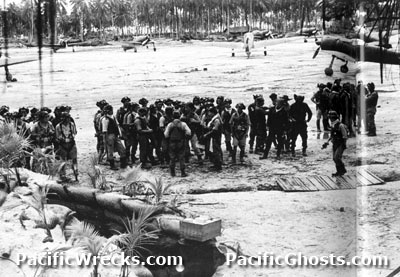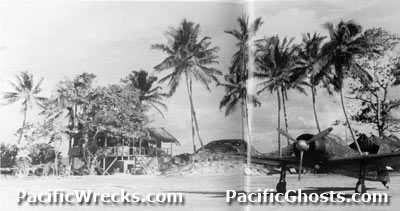582 Kōkūtai (582 Air Group)
Imperial Japanese Navy (IJN)
Background
On November 1, 1942 the 2nd Kōkūtai (2nd Air Group) was redesignated the 582 Kōkūtai (582 Air Group). Also abbreviated 582 Ku. The unit was part of the 26 Koku Sentai (26 Air Flotilla) at Rabaul. The air group that was a composite with a fighter butai (fighter unit) and bomber butai (bomber unit). The fighter butai was equipped with the A6M Zero. The bomber butai was equipped with the Type 99 Carrier Bomber / Ku Ku Kamba (Kanbaku) D3A1 Model 11 Val and later the D3A2 Model 22 Val.
Wartime History
In the middle of November 1942, the main body of the 582 Ku at Rabaul was detached to Lae Airfield and aircraft made sorties escorting convoys and operations over Buna. The 582 Ku also operated from other forward airfields including Hoskins Airfield and Gasmata Airfield on West New Britain.
On November 23, 1942
On December 1, 1942 A6M Zeros from 252 Kōkūtai (252 Air Group) and 582 Kōkūtai (582 Air Group) were flying patrols over a Japanese convoy of four destroyers including Isonami in the Solomon Sea off Gasmata bound for Buna. During the day, the Zeros reported engagements with B-17s. Around 1:00pm, the escort of six A6M Zeros from the 582 Ku that claimed to have hit the engine of one attacking bomber, possibly damaging B-17E "Miss Carriage" 41-2645 (MIA).
During late January 1943 operated from Kahili Airfield (Buin) on southern Bougainville and Munda Airfield on New Georgia.
On February 1, 1943 fifteen D3A Vals led by Lt. tTensai Kitamura ook off from Kahili Airfield (Buin) with escorted by forty A6M Zeros from 582 Ku and Zuikaku on an air raid againt American shipping off Guadalcanal. Approaching Tulagi, they spotted destroyers escorting LCT (LCT) and attacked. The D3A Vals dived bombed USS De Haven (DD-469) roughly two miles east of Savo Island and score three bomb hits and a near miss causing the destroyer to rapidly sink.
During early April 1943 participated in Operation I-GO air raid against Allied air power flying strikes against Tulagi, Milne Bay and Port Moresby.
On April 7, 1943 eighteen Vals took off on a dive bombing mission against U.S. shipping off Tulagi. Over the target, around 3:00pm clouds obscured the area before the located warships and dive bombed targets. Due to clouds, some Vals jettison eight bombs that landed astern of USS Ward (APD-16). The Vals claimed one cruiser sunk instantly and damaged another cruiser, transport and a PT Boat. Four Vals failed to return including Lt. Tatsuo Takahata, leader of the dive-bomber unit.
In early June 1943, Japanese correspondent Hajime Yoshida visits Ballale Airfield and photographed a briefing of 582 Kokutai pilots and A6M Zeros taking off. These photographs were likely taken on June 5, 1943.
On June 5, 1943 the unit's Zeros intercepted American aircraft attacking Japanese shipping between Shortland and southern Bougainville. The Zeros claim seventeen victories including Yamamoto claimed five dive bombers. They loose three aircraft and two pilots missing: PO1c Satoru Ogawa (Hei 2) and PO2c Shigehiko Ito (Hei 3).
During the middle of 1943, the unit used the tail code T3-??? (three digits). Later used tail code 82-??? (three digits).
On June 30, 1943 in the morning, the first Japanese air raid against Rendova by fifteen A6M Zeros from 582 Kokutai plus twelve A6M Zeros from 204 Kokutai led by CPO Hideo Watanabe with tweleve of the attacking Zeros armed with bombs and reached the area after 50 minutes and were intercepted by U.S. fighters and were unable to bomb the force and dog fights unfolded. The Zeros had no losses. Japanese claims: 582 Kōkūtai claimed ten shot down and two probables. 204 Kōkūtai (204 Air Group) claimed forteen shot down and four probables.
On August 1, 1943 the 582 Kokutai fighter unit was disbanded with the personnel transfered to the 201 Kokutai or 204 Kokutai with others sent back to Japan. Meanwhile, the 582 Kokutai bomber unit remained at Rabaul.
On
October 10, 1943 six Kates from 582 Ku took off on a night mission against U.S. shipping off Guadalcanal. On October 11, 1943 in the early morning the make a torpedo attack and damage SS John H. Couch causing fires and damage damages SS George H. Himes. This was the last damage to U.S. shipping off Guadalcanal due to enemy action.
On October 15, 1943 fifty-four Japanese planes including fifteen D3A Vals from 582 Kōkūtai (582 Air Group) escorted by thirty-nine A6M Zeros from 201 Kōkūtai (201 Air Group), 204 Kōkūtai (204 Air Group) and 253 Kōkūtai (253 Air Group) strike Allied shipping in Oro Bay off New Guinea. Over the target, they claimed 4 transports sunk and damaged. They were intercepted by P-38s and P-40s with 14 Vals shot down (seven missing and seven destroyed) plus five Zeros.
Between December 15-31, 1943 Vals from 582 Kōkūtai (582 Air Group) and 552 Kōkūtai (552 Air Group) fly missions against the U.S. landing and invasion force off Arawe (Cape Merkus).
December 15, 1943
(IJN) Seven D3A2 Vals from 582 Kokutai strike Arawe (Cape Merkus) at 7:30am local time.
Losses
582nd Kokutai
Val MIA (PO1 ?, PO2 Hotta)
Val MIA (LS Nishiki Ori, PO1 Saito)
Total = 2
December 17, 1943
Twelve D3A2 Vals from 582nd Kokutai plus D3A2 Vals from 552 Kokutai bomb Arawe (Cape Merkus) at 7:06am local time, claiming damage to one small cargo ship, 1 sea tiger and an LVCP sunk. Plus, one small and one sea tiger burning. Also, one P-43 [sic] shot down. Over the target, three Vals are lost. They report the American forces as APC 21, YMS 50, SC743
and 4 LSTs.
December
21, 1943 (first sortie)
Thirty-two D3A2 Vals (Twelve from 582nd Kokutai plus twenty from 552nd Kokutai) attack Arawe (Cape Merkus) between 10:55am until 11:08am and are intercepted by P-38 Lightnings.
December
21, 1943 (second sortie)
Eighteen D3A2 Vals (Nine from 582 Kokutai and nine from 552nd Kokutai) attack Arawe (Cape Merkus) at 3:45pm and claim 3 small transports sunk, 2 x LCT sea tigers sunk and ten small vessels burned, one large transport and part of the base destroyed. 20 x F6F [sic] and P-40s intercept.
Losses
552nd Kokutai
D3A2 Val pilot PO1 Honda, PO1 Tashiro
Total = 1
December 26, 1943
Japanese D3A2 Vals (15 x 582 Kokutai and 12 x 552 Kokutai) attack shipping off Merkus.
582nd Kokutai Vals claim 2 big cargo ships, 2 cruisers, 3 large cargo ships burning.
Losses
552nd Kokutai
D3A2 Val pilot LS Numao, observer PO1 Saruwairi **
December 27, 1943
On December 27, 1943 seventeen D3A2 Vals (8 x 582 Kokutai, two abort plus 9 x 552 Kokutai) attack shipping off Merkus escorted by 40+ Zeros. Lost were two D3A2 Vals from the 582 Kokutai. Also lost from 552 Ku was D3A2 Val piloted by Ishisugi (MIA). During a 45 minute attack the Vals attack PT-190 "Jack O' Diamonds" and PT-191 "Bambi" until P-47s arrive and intercept them. The PT boat gunners claim four planes shot down with Lt. Farley reporting "Toward the end of the attack, the enemy became more and more inaccurate and less willing to close us. It is possible that we may have knocked down the squadron leader as the planes milled about in considerable confusion, as if lacking leadership."
December 29, 1943
On December 29, 1943 seventeen Vals attack (9 x 582nd Kokutai, 8 x 552nd Kokutai) attack Merkus at 7:50pm and claim two PT Boats sunk and enemy base on island burned.
December 31,
1943
9 x Val attack Merkus at 13:15 and meet 30 fighters and claim cargo ships sunk. This was the last mission against Merkus
Captured Aircraft
Several 582 Kokutai aircraft were captured by the Allies between 1943–1944.
Abandoned at Munda Airfield was D3A1 Val 3470 Tail T3-261 largely intact, D3A2 Val 3029 Tail T2-222 and D3A2 Val 3106 Tail T3-260 were captured by U.S. forces in September 1943.
Abandoned at Lae Airfield were D3A2 Val 3023 Tail 82-227, D3A2 Val 3030 and D3A2 Val 3033. These Vals were among the Japanese aircraft captured by the Allies in the middle of September 1943.
Abandoned at Hoskins Airfield was D3A2 Val Tail 82-224 largely intact, captured by U.S. Marine Corps in May 1944.
Abandoned at Gasmata Airfield was D3A2 Val 3357 Tail 82-248 tail section only, salvaged and displayed at National Museum of the Pacific War (Nimitz Museum).
References
Kodochosho, 582 Kōkūtai, December 15, 1943–December 31, 1943
The First Team And the Guadalcanal Campaign pages 44
Japanese Naval Aces and Fighter Units of WWII page 158
Japanese Naval Air Force Fighter Units and Their Aces, 1932-1945 (2011) pages 57 (June 30, 1943) 231-232
Japanese missions against Arawe (Cape Merkus) December 15–31, 1943
Aichi D3A2 Val losses and air crews by Justin Taylan
South Pacific Air War: The Role of Airpower in the New Guinea and Solomon Island Campaigns, January 1943 to February 1944 (2024) by Richard Dunn pages 59-60 (February 1, 1943), 66, 220-221 (April 7, 1943)
Contribute
Information
Do you have photos or additional information to add?
|

